Palo Alto ATCX Mid Tower Case
Recently I tested the Palo Alto PA-600 case. I was impressed with the high
build quality and provisions for good ventilation. The only thing I would
have liked to see with the PA-600 was one more full bay, but in reality, that
was a minor complaint. Palo Alto was gracious enough to provide the more upscale
ATCX mid-tower for review. The similarity in design is apparent however there
are enough differences between these two cases to set the ATCX apart. What
really makes the ATCX unique is that it can be ordered in a mid-tower or a
desktop configuration.
First Impressions: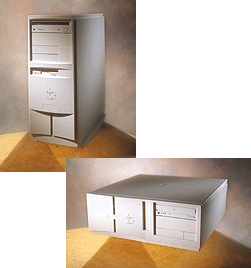
The box that the ATCX came
in was noticeably heavier than the box for the PA-600. This is due to the
fact that Palo Alto shipped it to me with the optional panels to convert it
into a desktop case. Be aware that when you purchase the ATCX you will either
get it as a desktop or mid-tower case and you wonít get the extra parts needed
for conversion. Some vendors do sell the optional kits to convert from one
format to the other. While looking at the front bezel I noticed that when
used as a desktop case that there is one less external half bay. You will
still be able to use the bay internally so the overall capacity of the case
is not changed. The case access panel is a little more difficult to remove
than the cover on the PA600. It utilizes a thumbscrew and two retaining mechanisms
that must be pinched inward while sliding the cover back. The unit features
the same high quality plastic as the previous case and deburred metal edges
within. Palo Alto puts high emphasis on being able to work on their cases
without tools. This is born out in features such as the front drive cradle
which houses the HD and the rear 92 mm fan mount Ė which slides and locks
into place without screws.
Included inside the case
with this evaluation unit was the optional 92 mm rear exhaust fan and what
Palo Alto refers to as the "Optional horizontal fan assembly for Slot
1 Pentium Processors". This device is a 92 mm fan mounted within a casing
that directs the air through a 90 degree bend. This allows the exhaust fan
to sit directly over the CPU heatsink and exhaust the hot air before it has
an opportunity to circulate through the case. This device relies on the low
height of a Pentium II processor and may not work with a PPGA or FC-PGA CPU
mounted on a slocket. I was able to use the assembly with my FC-PGA Pentium
III/iwill Slocket II combo by removing the metal grill on the fan. This gave
me the extra tenths of an inch I needed. Looking at the extra height of my
Abit Slotket it would not have worked, though I still could have used a conventionally
mounted 92 mm exhaust fan for that situation.
I mounted a 92 mm fan
in the front area reserved for the HD cradle. The cradle will hold in a HD
without the use of screws since its two clips pinch the HD in place. But guess
what? The clips that normally hold in the HD easily held the fan in place.
Be aware that if you mount a fan in this way youíll have to mount your HD
in one of the bays and use screws to retain it. The PA-600 has a molded area
in the front for an 80 mm fan but the ATCX came with no accommodations for
an intake fan. I think Iíd gladly give up using the HD cradle to mount a HD
in exchange for mounting a 92 mm intake fan in. I suspect I could have even
fit a 120 mm fan in it, with a little work, as long as it was the same depth.
You could even stack one 80 mm fan on top of another if that is what you have
available. Though Palo Alto didnít design the drive cradle for this purpose
it is perfectly suited to it. Even with two 92 mm fans, a slot fan, and the
power supply fan I found the ATCX to be surprisingly quiet and even quieter
that the PA-600. That was quite an accomplishment since I was already happy
with the sound nature of the PA-600.
The power supply that
is provided with the ATCX is the same 235 watt unit used in the PA-600. Although
its rating is smaller than most would like it still retains a lot of good
features. The bottom of the power supply features the same openings to allow
the removal of hot air from within the case. This power supply has 5 standard
power connectors and 1 floppy connector. If you somehow do cram 7 components
into the case, which it is capable of holding, youíll have to use a Y adapter
for 1 component to feed it power. That is still more power connectors than
most mid-towers have provisions for.
Features:
- ATX Format
- Provisions for an optional
92 mm rear exhaust fan and front intake fan (more on that later)
- 2 full bays
- 5 half bays (3 external)
- Standard 235 watt power
supply
- Dimensions: MT: 6.6"W
x 17.1"D x17.1"H DT:
16.5"W x 17.1"D x 6.1"H
- Weight: 20-lbs. 7 oz.
Installation and Testing:
I used an Abit BX6r2
motherboard inside this case as it is representative in size of most available
motherboards. Once again the motherboard fit easily. Palo Alto cases utilize
a unique mounting mechanism for the motherboard. They provide a bracket, which
is mounted onto the motherboard, that is then retained by one screw on the
outside of the case. This screw is in the area adjacent to where the peripheral
cards mount. While at first this seems odd it does speed installation and
is easier than using several screws to mount the motherboard. One improvement
that stands out over the earlier test case is the removal of the drive rails
used to retain all the drives in the PA-600. Although Palo Altoís drive rails
are definitely sturdier than a lot of the other ones Iíve seen Iíd still rather
use screws to retain my drives.
Extra Shots: (click to enlarge)
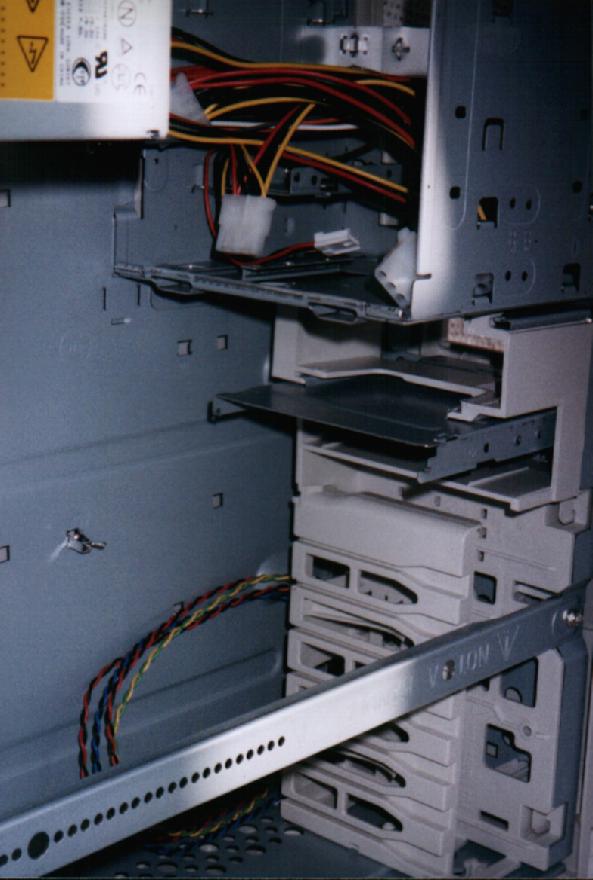 |
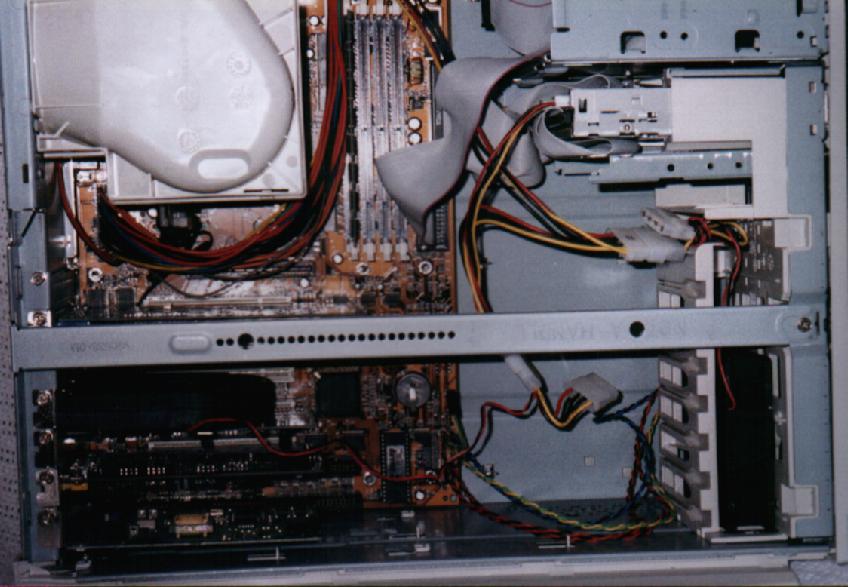 |
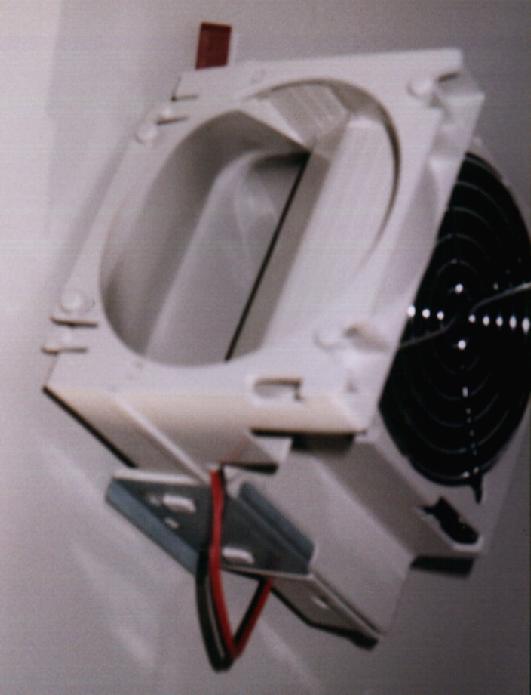 |
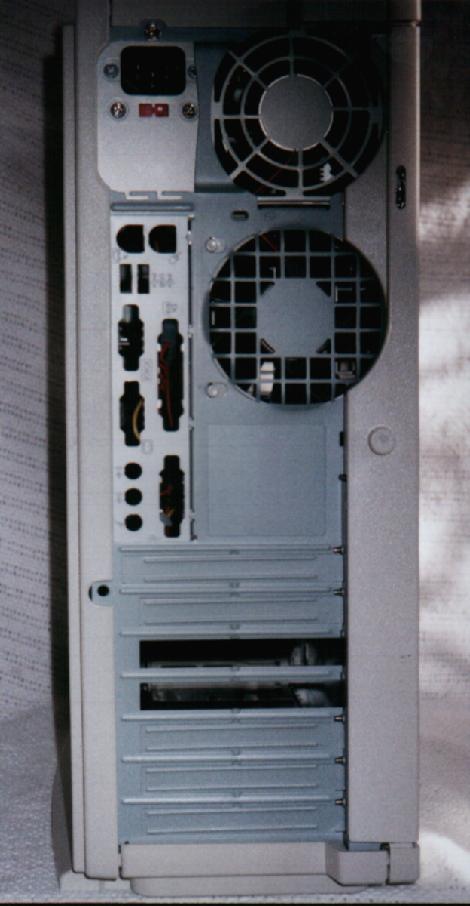 |
| Inside
Front |
Inside
board |
Fan
Adapter |
Back
View |
Pros:
- Same great Palo Alto
construction and quiet operation
- Accommodates a 92mm
exhaust fan
- Easily fits a 92mm
intake fan in the HD cradle (possibly a 120mm fan with a little work)
- One thumbscrew retains
the access panel
- One screw motherboard
mounting system
- The optional horizontal
fan assembly
- No drive rails
Cons:
- Only 2 full bays
- The side cover on the
PA-600 was easier to open
Conclusions:
The ATCX certainly does
not disappoint. With nearly the same dimensions of the lesser PA-600 case
Palo Alto was able to expand on the features already available on the PA-600
and even throw in an additional half bay. Keep in mind that the extra half
bay is immediately lost if you mount a 92 mm intake fan as I did, since you
will be relocating your HD there. With that in mind, I again would have liked
to see a third full bay since three external half bays is a little bit of
an odd configuration. With a floppy disk and internal Zip disk (or LS120)
installed that would still leave an extra half bay unused. Obviously all these
half bay accommodations would be great for someone with a lot of harddrives
to mount. Configuring with an extra full bay would have made the ATCX lose
its ability to convert into a desktop case. That is one compromise that couldnít
be avoided so in the end I was happy that at the very least I had that extra
half bay to relocate my HD to.
The horizontal fan assembly
is one of the best ideas Iíve seen in quite a while. With it I was assured
that the heat given off by the CPU heatsink was ejected quickly and efficiently.
I was very happy with the large intake fans this unit will hold in the drive
cradle. For an average size mid-tower you can set it up with good ventilation
without any case modifications. I highly recommend you purchase two 92 mm
fans to mount in this case. If you have the room above your processor, I would
definitely pony up the extra change for the horizontal fan assembly. They
even include a Sunon 92 mm fan with the horizontal fan assembly. Palo Alto
sells the ATCX from their website for $110, including shipping, but Iíve seen
it for as low as $85 at one of the authorized vendors listed on their site.
Reference: http://www.padg.com/pc/atxatcx.htm